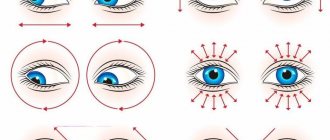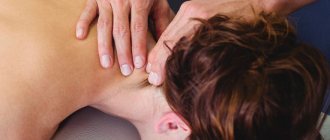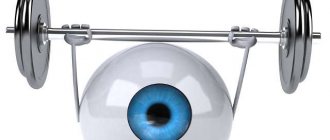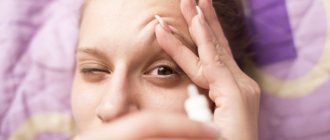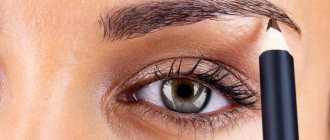Content:
- 1 A set of special exercises for the eyes
- 2 Bates exercise system
- 3 A set of exercises to correct myopia from M. D. Corbett
- 4 A set of exercises from R. S. Agarwal
- 5 A set of exercises for myopia according to the M. Windolf system
Description
Myopia, or myopia
, is one of the violations of the normal function of the eye in the perception of objects at different distances.
With myopia, a person usually sees objects located close to his eyes well, at a distance of 30-40 cm, but has difficulty distinguishing objects located a few meters away from him. The shorter the distance from the eyes to the object that a patient with myopia sees clearly, the greater the degree of myopia.
Traditional method of correcting myopia
is to prescribe glasses with concave lenses to the patient, which make it possible to ensure that the focus of the object in question falls on the retina of the eye, and not in front of it, and therefore the object in question becomes clearly visible.
However, glasses do not cure myopia
– they only compensate for the eye defect. Often, myopia progresses over time, and the patient needs to be prescribed glasses with an increasing number of diopters.
However, in alternative medicine
There are methods that can not only stop the development of myopia, but also significantly increase visual acuity.
One of these methods is a set of special exercises for the eyes.
, the regular and accurate implementation of which gives an undoubted positive result. For the treatment of myopia, several sets of exercises developed by different authors are most widely used.
It must be remembered that myopia
can develop both as a hereditary and acquired disease.
With a hereditary variant of the disease, a person whose one or both parents suffer from myopia has a very high risk of developing it at a fairly early age. In such conditions, exercises can be started even if there are no noticeable visual impairments or they are minor.
This is of particular importance if in a person’s everyday life there is a place for external factors, the impact of which further increases the likelihood of developing myopia, for example, work associated with viewing at close range (editor, proofreader, researcher, watchmaker, etc.). In this case, we can recommend performing a set of exercises developed by Professor E.S. Avetisov and co-authors.
exercises of this complex, when performed regularly, improve blood circulation in the eyes, strengthen the eye muscles, and relieve tension.
Traditional methods of treatment
How to restore your vision yourself? Traditional treatment of myopia cannot be considered as the main method of combating the disease. With the help of medicinal plants and certain foods, it is possible to provide the body with the necessary minerals and vitamins, which has a beneficial effect on visual function.
When visual acuity decreases, it is useful to eat foods that are rich in antioxidants - vitamins A, E and C. These are fruits and vegetables, herbs, blueberries. It is also useful to eat honey, as it is a natural biostimulant, it triggers internal biochemical reactions that protect against oxidative processes that negatively affect the organ of vision.
Myopia often causes visual fatigue. It can be reduced with the help of compresses based on tea leaves and chamomile infusion. The recipes help well with redness of the mucous membranes of the eyes. But if the risk of a bacterial infection is increased, then you cannot do without medications.
↑ A set of special exercises for the eyes
- Exercise 1.
Starting position – sitting, with a straight spine and raised head. Close your eyes tightly for 3-5 seconds, then open for 3-5 seconds. Repeat 6-8 times. - Exercise 2.
Starting position – the same. Blink quickly for 1-2 minutes. - Exercise 3.
Starting position – standing, feet shoulder-width apart. Look straight ahead for 2-3 seconds, raise your straightened right hand in front of you, move your thumb away and fix your gaze on it for 3-5 seconds. Lower your hand. Perform 10-12 repetitions. - Exercise 4.
Starting position – the same. Raise your straightened right hand in front of you to eye level and fix your gaze on the tip of your index finger. Then, without looking away, slowly move your finger closer to your eyes until it begins to double. Repeat 6-8 times. - Exercise 5.
Starting position – the same. Place the index finger of the right hand at a distance of 25-30 cm from the face at eye level, along the midline of the body. For 3-5 seconds, fix the gaze of both eyes on the tip of the index finger. Then close your left eye with the palm of your left hand and look at the fingertip with only your right eye for 3-5 seconds. Remove your palm and look at the finger with both eyes for 3-5 seconds. Cover your right eye with the palm of your right hand and look at the finger only with your left eye for 3-5 seconds. Remove your palm and look at the fingertip with both eyes for 3-5 seconds. Repeat 6-8 times. - Exercise 6.
Starting position – the same. Move your half-bent right arm to the right. Without turning your head, try to see the index finger of this hand with your peripheral vision. Then slowly move your finger from right to left, constantly following it with your gaze, and then from left to right. Repeat 10-12 times. - Exercise 7.
Starting position – sitting in a comfortable position. Close your eyes and use the fingertips of both hands to simultaneously massage your eyelids in a circular motion for 1 minute. - Exercise 8.
Starting position – the same. Eyes half closed. Using three fingers of each hand, simultaneously press on the upper eyelids with a light movement, remain in this position for 1-2 seconds, then remove your fingers from the eyelids. Repeat 3-4 times.
↑ Bates exercise system
The Bates exercise system has become quite widespread, especially abroad.
G. Bates is an American doctor who deals with the problems of various refractive errors. He developed special sets of exercises for the eyes for myopia, farsightedness and astigmatism.
The Bates method is based on the fact that accommodation, or the adaptation of the eye to equally clear vision of objects at different distances, is carried out not only by changing the curvature of the eye lens. In his opinion, a large role in the process of accommodation is played by the external muscles of the eyeball, which contract, put pressure on the eyeball and change its shape from spherical to elongated.
Bates thinks
that the main cause of visual impairment is tension, effort when trying to see any object. The cause of myopia is the effort to see distant objects. If a person performs work for a long time that involves examining small objects at a close distance, then he cannot immediately clearly see a distant object and therefore makes an effort to examine it.
At the same time, the brain commands the eye muscles to contract, and the normal shape of the eyeball changes. It becomes more elongated, as the contracting muscle presses on it and, as it were, flattens it, and this shape of the eyeball is the main cause and sign of myopia.
Thus, vision remains normal as long as the eyes are relaxed. You can restore impaired vision by achieving eye relaxation. It is on this principle that the entire system of Bates exercises is based, which includes three main sections: general relaxation, dynamic relaxation and additional methods to improve vision.
General relaxation is achieved by palming
. This technique was developed and put into use by Bates. It is quite simple to perform and is the easiest way to achieve relaxation. We will tell you more about palming in another article.
Dynamic relaxation is facilitated by performing exercises to improve central fixation.
Central fixation
- this is the ability of the eye to look directly at an object and see it better than all other objects. It is provided by the so-called center of vision, located in the central fovea of the retina, where the largest number of light-sensitive elements of the retina are concentrated and vision is the sharpest.
For myopia
As a result of constant eye strain, the normal structure and function of the center of vision is disrupted, and it is no longer the point that provides the sharpest vision. Its sensitivity becomes equal to the sensitivity of any other part of the retina or even less. Therefore, a person no longer sees most clearly the object at which he looks directly. Objects surrounding the subject are sometimes visible even better.
Therefore, Bates proposed exercises for training central fixation
. They are based on the assertion that when an eye with reduced vision consciously imitates the properties of a normal eye, visual acuity improves.
Bates exercises
are performed on a special Ohm card (Fig. 1). It is a rather complex pattern, and was used to train central fixation back in Ancient India.
In the center of the picture there is a sign in the form of a fancy hieroglyph, in which you can see the word “Om”. Exercises on the Om card increase the sensitivity of the central fovea of the retina, improve blood circulation in the eyes and help improve visual acuity.
- Exercise 1.
When performing this exercise, the Ohm card can be installed at a distance of 0.3 to 3 m at eye level. Fix your gaze on the starting point of the sign in the center of the Om map. It is noticeable that this point appears to be the clearest part of the sign. Then you need to slowly move your gaze along the sign, constantly paying attention to the fact that the clearest, most intense black color seems to be the part of the sign that your gaze is directed at at the moment. Repeat the exercise 3 times. After this, notice that now the entire sign seems darker than it was before the exercise. - Exercise 2.
The exercise is performed while standing. The Om card is located at a distance of 0.3 to 1.5 m from the face. The central sign on the Om card is surrounded by a broken line, similar to a schematic image of sunflower petals or sun rays. Fix your gaze on any part of this line, and then move it along the segments of the line, moving your head along with your gaze. At each corner, i.e., the end of each segment, you need to make soft blinks. When performing the exercise, pay attention to the fact that each line segment on which your gaze falls at the moment seems blacker than the rest. - Exercise 3.
Performed at the same distance from the Ohm card. There is a circle drawn around the sign on the map. Fix your gaze on a certain point on the circle and slowly move your gaze around the circle, simultaneously moving your head. Repeat the exercise several times. Then close your eyes and try to do the same, glancing over an imaginary image of a circle. - Exercise 4.
Hold the pocket version of the Sivtsev test table (a set of letters of different sizes arranged in several lines in descending order, used by oculists to check visual acuity) in an outstretched hand at eye level or place it on the table at a distance of up to 90 cm from the face with good lighting Perform an exercise to train central fixation, focusing your gaze on individual, clearly visible letters and noting their clarity. Then create dim lighting conditions, for example by covering yourself with a dark-colored blanket or turning off the electric light and leaving only a lit candle. Under these conditions, bring any book with small print closer to your face at a distance of about 25 cm and read 3 pages. Dim lighting should be such that the font can be read at a specified distance, but reading would be difficult. Alternating between central fixation on a test chart in good lighting and tense reading in dim light can improve visual acuity. - Exercise 5.
Read the test chart several times a day, placing it at a distance of 3 to 6 m, in good lighting and regularly blinking softly. It is better to start practicing from a distance of 3 m and gradually increase it, but so that there is no tension when reading. After reading the table, it is recommended to palm. - Exercise 6.
While walking or traveling in a vehicle (in the passenger seat), it is useful to regularly follow with your eyes objects moving towards and past: passing oncoming cars, passers-by. You should always try to keep your eyes relaxed, half-closed, but not squinted, and to look at distant objects without strain.
↑ A set of exercises for correcting myopia from M. D. Corbett
A set of exercises for correcting myopia was also created by M.D. Corbett. In her exercises, she recommends using a test table, but not using it as an eye test to see how many lines you can see. The use of the test table is based on the principles of recognition, examination of already familiar letters and, therefore, the absence of eye strain when examining it.
To perform these exercises, you must try to develop a feeling of indifference to this table, to break the usual associative connection between the table and checking visual acuity in the doctor’s office. Only after this the exercises performed will produce the expected effect.
However, in some patients this relationship remains in consciousness for a very long time, which naturally slows down progress in treating myopia with this method. For such people, M.D. Corbett suggests making a test chart yourself.
To do this, you need a standard sheet of Whatman paper and several unnecessary magazines and newspapers with headings of different sizes, printed in black ink. At the top of a sheet of whatman paper you need to glue a word (or phrase) printed in letters about 5 cm high. Stepping down 2.5 cm, glue another word (or phrase) printed in letters of a slightly smaller height.
In total, you need to make 20-25 such lines, each of which is a word of letters of decreasing height, and in the last, lowest line, the height of the letters should be no more than 1 cm. Considering the size of the letters, it turns out that only one will fit in the top line or two words, and at the bottom - a whole sentence. After creating this table, you need to make an exact copy of it on a card by typing the same words on a computer and printing on a sheet of A4 paper, maintaining the relative sizes of the letters in the lines and the spacing between the lines.
Before working with such a table, you need to conduct a short solarization
, performing head turns with eyes closed (we will talk more about this in another article). After solarization it is necessary to do palming.
Then you need to hang a large version of the test table in a well-lit place, sit at a distance of up to 2 m from it and begin the exercise. To do this, the manual format check table must be brought close to the eyes, so much so that you can see what is written.
From this distance, read the top line, then extend your hand with the card in front of you and read the same line from an arm's length distance. Repeat 2-3 times alternating between reading at close range and at arm's length. Then take a quick look at the top row of the large table.
The word written in it should be perceived more clearly. After this, close your eyes and make several small turns of your head to the sides, breathing deeply. Then look in the same way at the second line of the manual format table - close to your eyes, at arm's length, and after several repetitions - at the second line of the large check table.
Then close your eyes and try to write with the tip of your nose what you saw, but imagining it more clearly than they were actually perceived. Then open your eyes and quickly look at the second row of the large table. Now it is visible more clearly.
In the first lesson, you need to read each subsequent line of the table in a similar way until they are clearly visible, without eye strain. In the next lesson, progress will be noticeable, and after some time you will be able to easily read all the rows of the table from this distance. Then you need to move the chair another half meter further from the large table and repeat the exercise from the beginning.
Main condition
– do not rush to complicate the task, as this can lead to eye strain and not give the expected result. If the right and left eyes have different visual acuity, then before starting classes it is necessary to equalize them. To do this, the “stronger” eye is covered with a palm or a bandage, and the weaker one performs the same exercises, but from a closer distance. Every time you look at a large test chart, remember to take a deep breath and then exhale. When using this technique, distant objects are visible more clearly.
To complete the next exercise using the Corbett method, you need to make another table.
For this you will need a sheet of whatman paper, brushes and black ink or ink. You need to draw on this sheet several lines of three different letters of decreasing height, the sequence of which is described below, placing the letters strictly under each other. The top line consists of the letters P, B, O with a height of 7.5 cm; the next line is the letters A, O, C, 5 cm high; third – C, 3, T with a height of 4.5 cm; then - C, B, P 3.5 cm each; L, R, O 2.5 cm each; below – A, A, E 2 cm each; B, T, 3 – about 1.7 cm; L, I, R – 1.3 cm each; E, T, E – 1 cm each; H, M, H 0.6 cm each; I, N, I - even smaller in height and at the very bottom - E, E, E with a height of 0.3 cm.
As a result, if you read the letters in the columns, you get the phrase “Relaxation will return my sharp vision.” After the ink has dried, hang this table in a well-lit place and read the resulting phrase again, standing close to the table. This way, you know in advance which letters the test card contains, and this eliminates eye strain when looking at them. Then you need to carry out solarization and palming, as described in the previous exercise.
To perform the exercise
you need to sit at such a distance from the test table that you can clearly see the first line. Then close your eyes, remember the phrase written in the table, and try to figure out the letters that make up the second line. Write these letters with your nose as you exhale after a preliminary inhalation, open your eyes and take a quick, careful look at these letters. They usually become visible more clearly. If this does not happen, then you need to close your eyes again, imagine the letters of the second line and write them with your finger on your palm, and then open your eyes and quickly look at the table.
If this technique does not give the expected result, it means that the distance between you and the table is too large, and eye strain occurs when reading the table. Therefore, it is better to move your chair closer to the table so that you can easily distinguish the letters of the first line. After the second line becomes clearly visible, you can move on to the next one. When moving from one line to another, you need to give your eyes a rest by closing them and turning your head to the sides.
In one lesson you need to go through 4-5 lines and not linger long on the result obtained, trying to improve it in the next one. In addition, when performing this exercise, auto-training occurs. Repeatedly repeating the phrase “Relaxation will return my sharp vision” during the exercise is fixed in the patient’s mind and gives an additional positive result.
Exercise "Sharp Shooter"
is performed with the check table from the previous exercise, i.e. the phrase “Relaxation will return my sharp vision.”
Place the table in a well-lit place, read the phrase written in it at close range. As a preparation, carry out solarization and palming. Take a 1 m long ruler by the edges and place one end close to your nose, and point the other towards the top line of the test table. Looking at the near end of the ruler, you need to blink quickly and tell yourself: “Get ready!”
Take a quick glance at the far end of the ruler, blinking continuously: this will be tantamount to the command “Aim!” And then quickly look at the letter P in the first line of the table - the command “Fire!”
Then close your eyes, breathing deeply, and let your eyes rest. After this, do all three stages for the letters B and O. Having completed the exercise for the first line, you need to palm and move on to the next line. Similar exercises can be done on the first few lines.
M.D. Corbett recommends performing an exercise for myopia on the so-called “debko” table
. It is a drawing consisting of two black lines, with one black dot drawn at each end (Fig. 2).
Performing small turns of the head, you need to slide the tip of your nose and your gaze along these lines from one point to another. These turns need to be performed until there is a feeling that the lines are sliding in the direction opposite to the direction of view at the moment. Then the same exercise needs to be done for the bottom of the table.
Next, you should close your eyes and perform the same turns of your head, sliding your mental gaze along the imagined lines. After this, you need to open your eyes and glide your gaze along the white space between the two lines at the top and then at the bottom of the table. This technique will help you better distinguish letters when reading at any distance.
The following exercise helps improve vision in both myopia and farsightedness.
Its essence is to centralize vision, and not just improve it. To complete this, you will need a test table with the phrase “Relaxation will return my sharp vision.”
The table should be hung in a well-lit place and the phrase written on it should be read again at close range. Then, to prepare, perform solarization and palming.
You need to move away from the table to a distance at which the letters on the top line are clearly visible without any strain on the eyes. Having selected the first letter of the top line (P), you need to move your gaze from the white space (a blank section of whatman paper) to the right of the letter to the white space to the left of this letter, glancing over the image of the letter itself several times.
Thus, vision is, as it were, “ground in”, “sanded”; there is no need to make an effort to examine the object. The same technique must be repeated for the letters B and O. Then move the chair to such a distance from the table that these letters are distinguishable, but not clearly, and close your eyes. With your eyes closed, you need to remember, restore in your mind’s eye the exact image of the letter P on the table.
Point your nose towards the white surface to the left of the letter, then to the right, and thus make quick small turns of your head, sliding your mental gaze over the letter being imagined. Then open your eyes and perform the same technique with the same letter on the table. In this case, you can see the letter P on the table more clearly.
All the same must be repeated for the letters B and O. When performing this exercise, you need to pay attention to the fact that when the gaze is turned to the white space on one side of the letter, it appears to be away from the line of this gaze.
When you look at the white field on the other side of this letter, it seems that it seems to slide away from your gaze, as if it leaves its place and you see the white field again. This illusion must necessarily arise when performing the described exercise, since it is of great importance in the development of normal vision.
This “behavior” of the letter is called swinging, or shuttle movement. After swinging has been carried out for all three letters of the first line, you need to close your eyes and write these three letters with your nose. Then open your eyes, take a deep breath and read the word “relaxation” written in the table from top to bottom. It may become visible more clearly.
If this is really the case, then you need to read the entire phrase written in the table (“Relaxation will return my sharp vision”). If these words are not clearly visible, then you should imagine that you are reading them, mentally determining how they look on the table, because you know exactly what is written there.
Then you need to read each horizontal row of the table, consisting of three letters, in a similar way. After each line, give your eyes a rest and palm.
While palming, you can remember as many words as possible that begin with each letter from this line. Reading horizontal lines should be continued until the letters are clearly visible, without strain. After completing the exercise, you can pick up a rubber ball and play with it, hitting it on the floor, against a wall, or tossing it and catching it each time, and you must follow it with your eyes.
Healthy food for myopia
Blueberries and carrots are the healthiest foods for myopia. And if you can eat blueberries just like that and it will be beneficial, then carrots are just not healthy. It is useful in symbiosis with fats. Grated carrots can be mixed with olive oil or sour cream; pumpkin oil is also suitable. Zinc is useful for myopia. The most zinc is found in the following foods:
- Sprouted wheat;
- Apples;
- Oranges;
- Lemons;
- Sesame;
- Peanut;
- Figs;
- Grapefruits;
- Honey;
- Oatmeal;
- Barley groats;
- Syrup;
- Cocoa;
- Egg yolk;
- Beef liver;
- Rabbit meat;
- Cheese;
- Sea bass;
- Pork liver.
It is important not to overdo it with zinc, as its excess provokes the formation of cholesterol plaques in the blood.
↑ A set of exercises from R. S. Agarwal
R. S. Agarwal for myopia
recommends performing an exercise to remember any letter of the test table. For 5 seconds you need to look at any letter, blinking continuously. At this time the letter is remembered. Then close your eyes and try to remember it and create a mental image of it, more clearly than when looking at it.
During such a memory, you can open your eyes several times and look at the letter, trying to recreate a clearer mental image. After completing the exercise, your vision should improve. This occurs when the letter is visible equally well with both eyes open and closed.
Useful tips
Answering the question of how to improve vision with myopia, experts advise, along with eye exercises, every day, if the health of the pancreas allows, to drink half a glass of carrot juice, fresh from the juicer. Taking a vitamin such as vitamin A also helps in the treatment of such ophthalmological diseases as myopia. Eat blueberries and strawberries. Kefir, fermented baked milk and cottage cheese are also very useful. Do not read while lying down or on public transport. Don't watch TV lying down.
If, due to the nature of your work, you are forced to sit in front of a computer all day, take a rest break at least every half hour. During these breaks, perform the eye exercises described above. It would be prudent to just lie down with your eyes closed if there is such an (excellent) opportunity (if you work from home, for example). You can sit for half an hour with your eyes closed. When spending your leisure time or working at the computer or when you are watching TV, the room should not be pitch dark. Dim light must be present. Spend at least 1 hour outside while walking. Do not read books, newspapers or magazines while lying on the bed before going to bed. Do not lie with a laptop on your stomach, watching movies or news, or surfing social networks.
If you have to work with small objects, they should be well lit so that your eyes do not strain while working. Everything listed above will help maintain good vision and improve the condition of existing vision.



